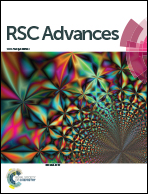Corrosion behavior of 316L and 304 stainless steels exposed to industrial-marine-urban environment: field study†
Abstract
The present investigation extensively compares the pitting corrosion behavior and mechanical stability of 316L and 304 stainless steels (SS) exposed to an Industrial-Marine-Urban (IMU) environment for 3 years from April 2012–March 2015. The surface morphology of the stainless steels exposed to the above environment was studied by atomic force microscopy (AFM) and scanning electron microscopy equipped with energy dispersive X-ray analysis (SEM-EDAX). Mechanical stability of the exposed samples was monitored by the Vickers microhardness test. Corrosion behavior of exposed samples was monitored by electrochemical impedance spectroscopy (EIS) and potentiodynamic polarization studies. FT-Raman spectroscopy was employed for investigation of the atmospheric corrosion products; this offered much interesting information that eventually helped to understand the various corrosion phenomena that had occurred during the periods of 3, 6, 9, 12, 24, and 36 months to identify corrosion products which could not be evaluated from XRD analysis. The experimental results clearly show that both 316L and 304 SS were affected by pitting corrosion from the dissolution of Mn present in the alloy due to atmosphere electrolytes. Pit initiation occurs with the high amount of Cl− present as a highly corrosive agent. Hence, high pit density was observed in 304 because of the selective dissolution as MnS present in the alloying elements. However, presence of SO2 in the atmospheric location enhances pitting corrosion resistance by inducing a stable rust layer (Goethite) to form. Meteorological data and weight loss results clearly demonstrated that decreases in corrosion rate (which was due to the formation of a highly adherent passive film) occur remarkably during the dry season. The present investigation has observed a very high relative humidity (RH) value in the Chennai region of India. Very high RH reveals the presence of a thick water layer on the metal surface which acts as a sink to form the passive film. The electrochemical studies of atmospherically corroded 316L SS depicts passivation behavior whereas the 304 SS does not show any passivation behavior in the IMU region of Chennai.


 Please wait while we load your content...
Please wait while we load your content...